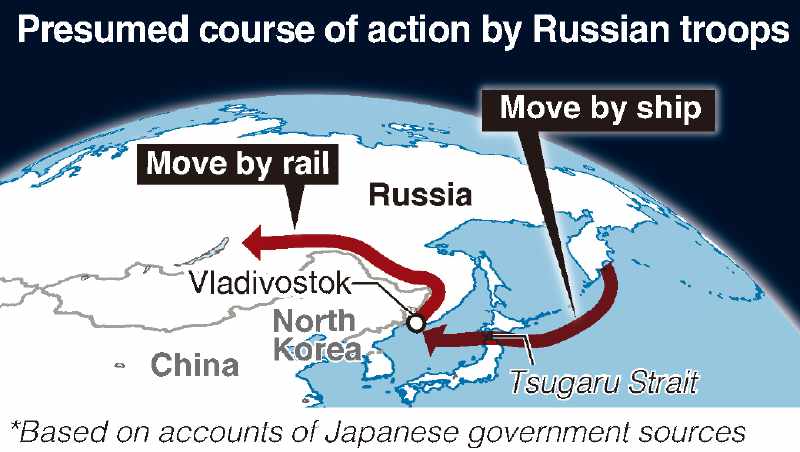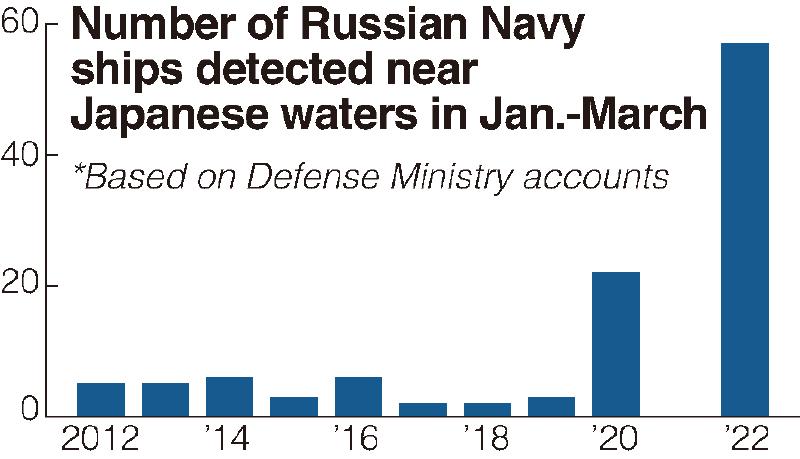
A Russian Navy tank-landing ship with multiple vehicles on its deck sails in waters near Japan on March 15.
15:00 JST, April 7, 2022
On the evening of March 15, the Maritime Self-Defense Force detected two Russian Navy ships heading west in waters about 70 kilometers east-northeast of Shiriyazaki cape in Aomori Prefecture. The Shiranui, a destroyer from the Ominato base in the prefecture, and a P-3C patrol plane from the Hachinohe Air Base, also in Aomori Prefecture, began tracking the Russian vessels.

The Russian ships eventually passed through the Tsugaru Strait between Honshu and Hokkaido and reached the Sea of Japan. Photographs taken from the P-3C clearly showed at least 10 vehicles loaded on the deck of one vessel.
This incident was another indication of increased Russian military movements in the vicinity of Japan since before Moscow launched its invasion of Ukraine. The Self-Defense Forces confirmed that a total of 57 Russian Navy ships sailed through waters close to Japan from January to March — more than were recorded during that period in the past 10 years combined. In addition to transporting units from Russia’s Far East toward Ukraine, Moscow has been conducting military exercises and apparently aims to flaunt its military might in areas near Japan.
According to the Defense Ministry, the two Russian vessels were tank-landing ships. On March 16, two more Russian ships passed through the Tsugaru Strait. Under international law, foreign military ships may freely pass through this strait. At a press conference on March 17, Chief Cabinet Secretary Hirokazu Matsuno said it was “possible” that Russia was transporting combat vehicles and personnel to Ukraine.
According to Japanese government sources, Russian units stationed in the Kamchatka Peninsula and elsewhere in the Far East had massed in Vladivostok and possibly moved toward Ukraine on the Trans-Siberian Railway.
Statements issued by Ukraine’s Defense Ministry and other sources say Russia’s 64th separate motorized rifle brigade, which is suspected of involvement in the mass killing of civilians in the Kyiv suburb of Bucha, was originally based in the outskirts of the Far Eastern city of Khabarovsk.

Northern territories used
As well as sending units into combat, Russia also has been stepping up drills involving its ships.
A Yomiuri Shimbun analysis of SDF statements on Russian vessel movements from January to March revealed that 57 such ships were detected in waters near Japan, including the Tsugaru Strait, the Soya Strait and the Tsushima Strait. This figure eclipsed the total of 54 ships detected during the same months from 2012 to 2021 combined.
According to officially published documents, the number of Russian Navy vessels confirmed in those waters in January this year was zero. However, Russian vessels have been spotted frequently since Feb. 1. At least 20 ships have been detected near the Soya Strait and the Tsugaru Strait since Russia invaded Ukraine on Feb. 24.
Many of these vessels appear to have participated in large-scale exercises in the Sea of Okhotsk and the Pacific Ocean. “The sea often gets rough during the winter months, which can restrict exercises such as those involving helicopters landing on and taking off from ships,” a senior Japanese Defense Ministry official told The Yomiuri Shimbun. “Conducting these drills at this time is aimed at displaying their military capabilities.”
Russia also has conducted military exercises in the northern territories. On March 25, the Russian military announced it had started a large exercise involving more than 3,000 personnel in the northern territories and Russia’s own Chishima archipelago. This appeared to be retaliation for Japan imposing sanctions on Russia over the invasion of Ukraine. Anti-tank missiles and drones were reportedly deployed for the exercise.
Russia apparently conducted a target practice drill on the evening of March 30. Crew members on a Nemuro Coast Guard Office patrol boat sailing in waters near Nemuro, Hokkaido, saw lights that appeared to be flares. For about an hour from 6:30 p.m., these lights constantly illuminated the sky in the direction of Kunashiri, an island north of the boat’s position. “I’ve never heard of anything like this happening before,” said an official of the coast guard office.
Russia-China cooperation
Joint Russia-China activities in areas near Japan also have been conducted in recent years. Whether these actions will continue in the wake of the invasion of Ukraine is a focus of considerable attention.
In October, a group of 10 Russian and Chinese ships for the first time sailed jointly through the Tsugaru Strait and the Osumi Strait. The flotilla sailed in a loop around almost the entirety of Japan. In November, a total of four Russian and Chinese bombers flew together over the Sea of Japan, East China Sea and Pacific Ocean. The Air Self-Defense Force scrambled jets in response.
Katsutoshi Kawano, a former chief of staff of the Joint Staff Office, said: “China is carefully thinking about its own position, including the pros and cons of helping Russia’s blatant act of aggression. Analyzing the exercises Russia and China have conducted in the Far East reveals a lot about their relationship. This situation will need to be closely monitored.”
Far East military buildup
In the closing days of the Cold War, Soviet forces in the Far East included about 390,000 ground troops and 240 surface ships and submarines facing the Japan-U.S. alliance.
These numbers were slashed after the Soviet Union collapsed, but cutting-edge equipment has been deployed in the region in recent years as Russia once again reinforces its military might.
According to the Defense Ministry’s white paper and other sources, Russia’s Eastern Military District, which covers the Far East region, has ground forces comprising about 80,000 personnel. The district’s naval power includes about 20 main surface ships and 13 nuclear-powered submarines. Several nuclear-powered, ballistic missile-carrying submarines operate in the Sea of Okhotsk, and Russia is installing surface-to-ship missiles that could strike approaching enemy vessels.
The northern territories protrude into the Sea of Okhotsk, making them extremely important from a military perspective. Russia has stationed about 3,500 personnel of the 18th machine gun and artillery division, as well as tanks, armored vehicles and artillery, on Kunashiri and Etorofu islands.
"World" POPULAR ARTICLE
-

8 Japanese Nationals Stranded on Indonesia’s Sumatra Island
-

U.S. Senate Resolution Backs Japan, Condemns China’s Pressure
-

China to Impose Sanctions on Shigeru Iwasaki, Former Head of Japan’s Self-Defense Forces, Who Serves as Adviser to Taiwan’s Executive Branch
-

South Korea’s Top Court Dismisses Nippon Steel Appeal in Lawsuit over Requisitioned Worker
-

75% of Myanmar People Reject Army’s Political Involvement, According to Survey Conducted by Aid Organization
JN ACCESS RANKING
-

Tokyo Economic Security Forum to Hold Inaugural Meeting Amid Tense Global Environment
-

Keidanren Chairman Yoshinobu Tsutsui Visits Kashiwazaki-Kariwa Nuclear Power Plant; Inspects New Emergency Safety System
-

Imports of Rare Earths from China Facing Delays, May Be Caused by Deterioration of Japan-China Relations
-

University of Tokyo Professor Discusses Japanese Economic Security in Interview Ahead of Forum
-

Japan Pulls out of Vietnam Nuclear Project, Complicating Hanoi’s Power Plans
























